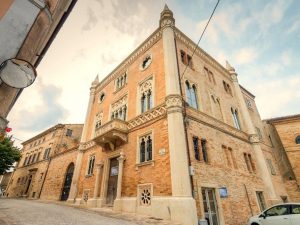Italy’s enchanting towns and countryside are a melting pot of interesting properties, from grand old farmhouses to character village homes. We highlight five of the most popular and tempt you with examples for sale. Which would suit you the most?
Casa d’epcoa
A general term for a period or character home, which means they are older properties from a defined era that boast distinctive architectural features. These can be in any location but typically are apartments or terraced houses in the historic quarter of towns or villages, grand waterfront palaces, urban and rural villas or historic country houses.
Highlights often include tiled or terracotta floors, beamed and vaulted ceilings, fireplaces, external shutters, marble fittings, ornate surrounds, decorative ironwork – especially doors, windows and balconies, loggias (colonnaded porches) and even original frescoes.
This three-bedroom townhouse is typical of the gems you can find in Umbria’s ancient towns and villages. Recently restored, it’s bursting with features and is even built over a Roman theatre.
Casa colonica

3-bedroom casa colonica in Chianciano, Tuscany
A common term to describe a large farmhouse in the Italian countryside, usually a few minutes’ drive from a village and often reached via its own winding tree-lined drive or track. Typically, they come with a few hectares of olive groves and/or vineyards, a garden with terraces and swimming pool, and outbuildings, often converted to guest accommodation. This type of property, usually of stone construction and converted to a high standard, is especially popular with foreign homeowners in Tuscany and Umbria. These days, it’s not unusual to find them split into two or three apartments or dwellings.
Other words used for an Italian farm or farmhouse include ‘cascina’, ‘casale’ and ‘fattoria’, while ‘casa rurale’ means any type of country dwelling, large or small. Many of today’s casa colonicas are run as ‘agriturismos’, which means the owners offer bed and breakfast to paying guests, who get a true flavour of life in the Italian countryside.
This stunning three-bedroom, three-bathroom farmhouse in Tuscany has been restored to allow flexibility and could work as a private house that also offers tourist accommodation.
Masseria
Italy’s southern region of Puglia has its own take on large medieval farmhouses, ones that historically belonged to noblemen and formed the focal point of sprawling agricultural estates, often with accommodation for workers. Cue the masseria, a term that is also used in Sicily.
The most authentic ones date back to the 16th and 17th Centuries and their grand, fortified architectural style contrasts with farmhouses in the rest of Italy. They are characterised by towering stone walls, solid square layouts, an abundance of outbuildings and surrounding walls. In recent decades, they have become an obvious target for converting into luxury hotels or boutique bed and breakfasts, but they make equally impressive private residences. Most come with independent guest accommodation, space for a pool and terraces and land for olive groves and vines. Just ask Dame Helen Mirren, who owns a masseria in the Lecce province.
This charming eight-bedroom property, located just inland of Brindisi, ticks all the boxes expected of a traditional masseria and is set within orange and olive groves.
Palazzo
The clue is in the name with this one. Typically a large period mansion, an Italian palazzo (literally ‘palace’) are some of the country’s most desirable properties. Originally associated with Renaissance architecture, most notably seen along Venice’s canals, in Tuscany’s famous cities, especially Florence, and along the shores of the Italian Lakes, the palazzo is also a revivalist style adopted in the 19th and early 20th Centuries.
Built primarily as grand town houses for wealthy merchants and nobility, palazzos are built over several storeys and packed with features, such as arches and columns, marbles floors, majestic staircases and ornate balconies. With an impressive street – or water – frontage, characterised by porticos, cornices and neat rows of windows, to the rear many have courtyard areas. Like most palazzos, this one for sale in Le Marche definitely has the wow factor.
Trullo
Back in Puglia, an unmistakable type of character property that is unique to the region is the trullo. Instantly recognisable for their conical roofs and stone walls (often painted white), most trulli (plural) are located in the Itria Valley area, the largest concentration being in the town of Alberobello, a Unesco World Heritage site. For a more rural setting, the countryside around the nearby towns of Martina Franca, Ceglie Messapica and Ostuni is dotted with these quirky buildings.

4-bedroom Trullo in Martina Franca, Apulia
Trulli are famed for their shape and drywall (mortarless) construction, a centuries old building technique still used in Puglia and which must be used during restoration. A single trullo is not large enough for modern-day living, so most come connected to a rectangular extension (lamia) or it’s common for a cluster of trulli to be connected to create a suitable living area. Available in various states of repair, most come with a plot of land with fruit trees and space for a pool.
This one we’ve picked has three bedrooms in the main living area, plus a one-bedroom annexe – not forgetting it has five cones on the roof!
Written by Overseas Guides Company.
For more information on buying abroad get your FREE Country Buying Guide!




See all available country guides
If you are considering an overseas property purchase, whether for lifestyle or investment, opening a no-obligation account with FCA-authorised Smart Currency Exchange will enable you to benefit from their competitive exchange rates and specialist currency knowledge, ultimately saving you money and time. For more information, download Smart Currency Exchange’s free report or visit the Currency Zone.



